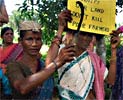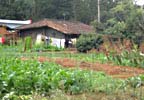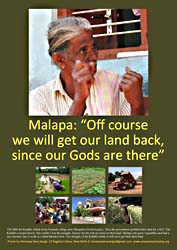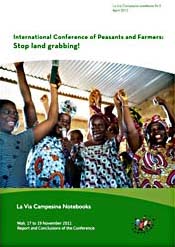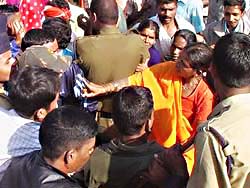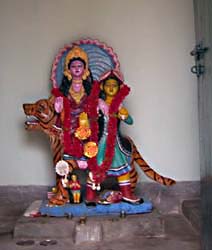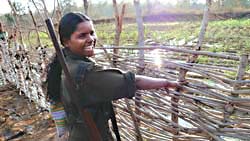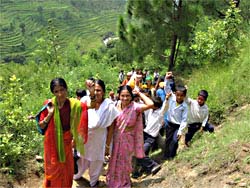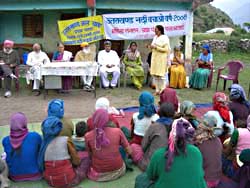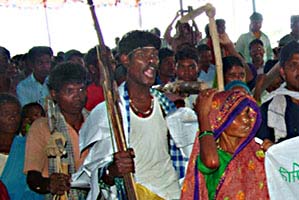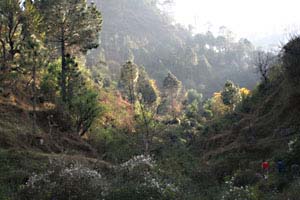ARCHIVE
India from 2008-2013
Stories and Photos
_______________________
The Struggle of the Kudubis
October 2008 the world of the Kudubis from Padavu near Mangalore,
Karnataka, collapsed. With the help of police and goons the government
dumped hundreds of truckloads mud on their fields. The Kudubi Adivasis
together with local activists and city people resisted fiercely. One
of them was Malapa.
Read more and download the poster!
map
_______________________
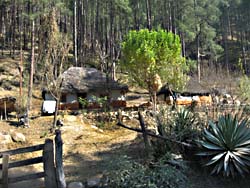 Many
communities in the Tauns Valley in North India live in the forest with
their cattle for generations. Now they have to leave for a six
dams-tunnels project.
Many
communities in the Tauns Valley in North India live in the forest with
their cattle for generations. Now they have to leave for a six
dams-tunnels project.
Resistance Against Dams
Uttarakhand Center - Visit End 2011
Making the Forest Act Alive
'Whatever Small Voice We Have'
Dalit Activist in the Tauns Valley
map
The problems for farmers worldwide are becoming worse from year to year.
Especially the situation for peasants and landless farm labourers in the countries of the South are dramatic. Loss of land and commons, migration, poverty and hunger are growing. In many villages everywhere in the South peasants are struggling for their land, water, commons and culture. They claim more economic and cultural autonomy: Peasant Autonomy. This autonomy is necessary to overcome the daily humiliation, oppression, poverty and hunger.
This website tells the stories of the village struggles in India. It also shows how the same villages go on
A well balanced combination of struggle and development of the rural economy and culture will be the most successful way to peasant autonomy.
Peasant Autonomy is not about opinions or ideology, theory or political vision. It is about the experiences of villages struggling for their autonomy, against displacement and for the prosperity of a rural economy and culture.
Peasant Autonomy is a tribute to all the peasants, women and men, who go on with their struggle year after year.
Read more in About us and in The powerful combination
 Phool
Dass, dalit village headman.
Phool
Dass, dalit village headman.
'Don't Touch the Khaddi People'
What can you do against bribes government officials always force
villagers to pay? In Khaddi, a village in the Himalayas they found an
answer. When officials didn't want to give the villagers the full
payment for their work, women occupied the office, locked up the
officials and phoned up higher level officials and journalists.
It all started in 2009 when Phool Dass became village headman of
Tipli, one of the four villages of the Khaddi municipality. Dass is a
dalit, a member of the lowest cast ...
Read more about this
struggle, or go to the overview
of Uttarakhand South-West 2; articles, photo series map
_______________________
Via Campesina
a Global Peasant Movement
Via Campesina is a global peasants' movement fighting for food sovereignty. It published a lot of booklets about all political issues relating to peasants. For example: 'Stop Land Grabbing', 'Peasants Can Feed the World', 'No To Violence Against Women' and 'Small Scale Farmers Are Cooling Down the Earth'. Read more
_______________________
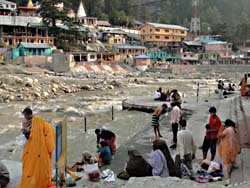 The life
of Himalayan is closely linked with the rivers.
The life
of Himalayan is closely linked with the rivers.
Himalayan Waters
This documentary gives a quick overview of the
water problems in the Himalayas.
It also shows how villagers and their local organizations struggle
against hydro power projects and deforestation and for safe drinking
water; to protect their life and
Read more; link to the documentary map
_______________________
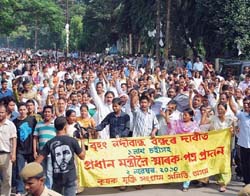 Protest
rally against large dams in the Brahmaputra river.
Protest
rally against large dams in the Brahmaputra river.
Assam, crossing ethnic lines
In Assam many different people live together. Till several years ago
there was a lot of violence between the different communities and
their fighter groups. Now people struggle together against evictions,
crossing ethnic lines.
Read more about this struggle, or
go to the overview of Assam; articles,
photo series map
_______________________
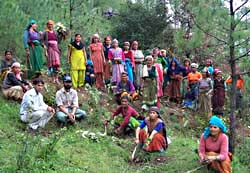 Farmers ready to plant saplings at the village
forest the Forest Department snatched away.
Farmers ready to plant saplings at the village
forest the Forest Department snatched away.
Do-it-yourself
Reclaiming the Village Forest
"It will only cost you 100 till 200 Rupees (1, 50 till 3 euro) and
two visits to the district office to get back the lost parts of your
village forest." Rakesh Bahuguna from the small development
organisation Himcon in the North-India state Uttarakhand is
enthusiastic. "We got back 6 hectares from the Forest Department, and
we claim another 7 hectare. On the first part the villagers already
planted oak trees."
Read more + photos map
_______________________
Stiff Resistance for Many Years
Villagers from Saraipalli stopped the pump house of the Jindal iron
factory. Ten years ago the company started to build a dam to make an
artificial lake to collect water for their factory. By the stiff
resistance of the villagers the plans were delayed for two years.
Jindal promised the villagers one job at the factory for every family.
But they never kept their promise.
Read more More photos map
_______________________
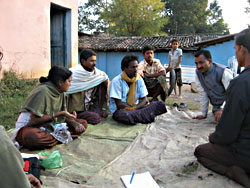 Activists inform villagers about new projects.
Activists inform villagers about new projects.
The Power of
an Independent Organisation
One thing is clear: to be independent is the most important thing,
when you want to support the Adivasis in their struggles against land
grab.
Read more map
_______________________
Bon Bibi Legend and 'Ethnic Cleansing' of India's Forests
Amitav Ghosh
Indian writer Amitav Ghosh is very angry about the Indian forest
policy: "Over many decades, there has been a kind of 'ethnic
cleansing' of India's forests: indigenous groups have been evicted or
marginalised and hotel chains and urban tourists have moved in." With
the help of the beautiful Bon Bibi legend from the Bengal mangrove
forests Ghosh describes the relationship between the villagers and
their forests. He warns the political disempowerment of the forest
dwellers will not continue forever. Read
more map
Download full article from Amitav
Ghosh: 'Wild Fictions', 7 pages in Word, 7 photos; 400 KB.
_______________________
Arundhati Roy With the Guerillas
roaming around in the forest for several weeks
The famous Indian writer and journalist Arundhati Roy traveled around
with the Maoists in the center Indian state Chhattisgarh for several
weeks. The guerillas are mostly young tribals (women and men) fighting
against oppression and displacement for dams and mines and for their
autonomy as small farmers with their own local culture.
Roy: "The antagonists in the forest (of the government and companies)
are disparate and unequal in almost every way. On one side is a
massive paramilitary force armed with the money, the firepower, the
media, and the hubris of an emerging Superpower. On the other,
ordinary villagers armed with traditional weapons, backed by a
superbly organised, hugely motivated Maoist guerrilla fighting force
with an extraordinary and violent history of armed rebellion."
Go to the introduction article
or download the whole article
(in Word, 1.5 MB)
_____________________
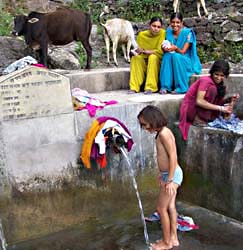 Villagers meeting each other at
the spring.
Villagers meeting each other at
the spring.
Village Life in Kimsar
Rajaji National Park, near Rishikesh
_____________________
The Powerful Combination
Building Up and Criticizing
at the Same Time
What is the best way to revitalise the rural areas? Is it by development projects like planting trees, building water harvesting structures or starting a small factory to process medical herbs? Or is it by campaigning against a corrupt Forest Department and government? Both constructive work and campaigning have to be done. At the same time. Constructive work without changing the system is useless, because the system will destroy the livelihood of the people faster than we can build up. But campaigning without constructive work can easily become sterile. Even when the slogans hit the nail on the head, people cannot eat slogans. But the combination of building up village economy with campaigns to protect the rights of the villagers is powerful. Read more map
_______________________
Sitting on the Fence
Letter from a Middle Class Activist
It is a terrible idea that we, middle class activists, sit at the fence, when 'our people', the small farmers, are killed by the government. Killed by decades old exploitation, by displacement for mining and so many other projects and now killed as collateral damage for hunting the 'Maoists'. At the same time we are sitting on the fence, doing almost nothing. Traveling, having some discussions, writing an article, making a picture, compiling a website. Read more Print Nederlands Druk af
_______________________
Village Women Stopped
Power Project
The people of Pala village stopped the construction of a hydropower tunnel twice. The local women's group put Raksha Sutra (holy threads) on the trees the contractor wanted to cut for a road. Later on they chased the workers away when they started felling in the night. Read more map
_______________________
‘We are Living Here for Generations’
Forest Dwellers in Sariska Tiger Reserve Will not Leave
In the north of the West Indian state Rajasthan we find the Kankwari fort. It is on the top of a hill. It looks like a fairytale castle with big towers and solid walls. At the foot of the hill flows a friendly small river to a small lake with date palm trees and a village. The cows and buffalos just came back from the forest and are milked now. Some goats are grazing next to the farms. Yes, it looks so idyllic. But at the same time a serious struggle is going on. Read more map
_______________________
Yearly Commemoration
Yearly commemoration of the police violence at Tamnar, Chhattisgarh. More photos map
_______________________
Iron Factories
Pollution, displacement and resistance
The last twenty years hundreds of iron factories came up in the centre of India, in the states Chhattisgarh, Jharkhand, Orissa and West Bengal. Life became a hell for the hundred thousands of villagers in their neigbourhoods, most tribal people. The air, the water, the land everything became horribly polluted. It brought many diseases. Big trucks killed a lot of people in traffic accidents. Thousands and thousands Adivasis had to leave for the factories, and for the coal and iron mines. They became displaced persons. Off course there is a lot of resistance. map
Read the introduction
article about resistance
Read the introduction article
about pollution and displacement
Go to overview photo
series about pollution
Go to overview photo
series about resistance
_______________________
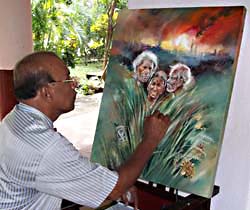 Painters went to the villages, had
discussions with farmers and made paintings.
Painters went to the villages, had
discussions with farmers and made paintings.
Artist Support Struggle
Artists from Mangalore supported the Kudubis in their struggle against land grab for a Special Economic Zone. More photos map
_______________________
Mother Earth - a New Future for Small Farmers
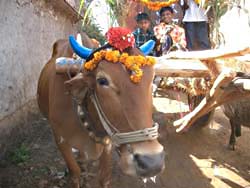 Every year there is a festival to
celebrate the richness of the tradional seeds.
Every year there is a festival to
celebrate the richness of the tradional seeds.
Documentary about poor women farmers in the South of India who turned their back to modern agriculture in order to bring new life to their traditional ways of farming. With a lot of success! Read more; link to the documentary
_______________________
resistance in Uttarakhand
beauty of Uttarakhand
farmers' paradise Mangalore
destruction for oil refinery
Arundhati Roy - Narmada dam
Yekkaru will not leave
victory over mining giant
factory, pollution and protest
shareholders meeting in London
